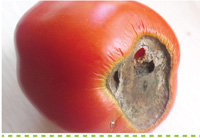|
What are Blossom End Rot symptoms?
A common ailment of tomato and capsicum is blossom-end rot. This condition affects the fruit — not the blossom or flower itself. The condition gets its name because the symptoms appear at the ‘blossom end’ of the fruit — the opposite end to the stem.
The first sign of blossom-end rot is that the end of the fruit becomes off-whitish to brown in colour and takes on a ‘sunken in’ appearance. As the fruit matures, these symptoms become more pronounced and the colour of the rot becomes dark brown to almost black.
Blossom end rot is caused by insufficient calcium supply however, the most common cause is from irregular or insufficient water during the critical growing period of the young fruit. Even when calcium is in sufficient supply, a plant receiving insufficient or irregular water will have difficulty absorbing and delivering calcium to the fruit.
How to control Blossom End Rot
-
Boost the soil with calcium by adding lime, dolomite, gypsum or composted animal manures. (It is recommended you do this before planting. Do not wait until the appearance of symptoms as by this time, all affected fruit will be ruined.)
-
The second measure is of course, to water regularly. As most tomato and capsicum crops continue to flower and bear fruit for prolonged periods of time, ensure you water regularly to keep the roots moist. You should then find that new fruit will be trouble-free.
-
Avoid excessive nitrogen fertilisers. Nitrogen fertilisers will promote leaf growth at the expense of fruit and allocate calcium to the leaves instead of the fruit.
-
Don't plant plants close together and water regularly. It is the inconsistent watering that develops calcium deficiency.

|
|
|